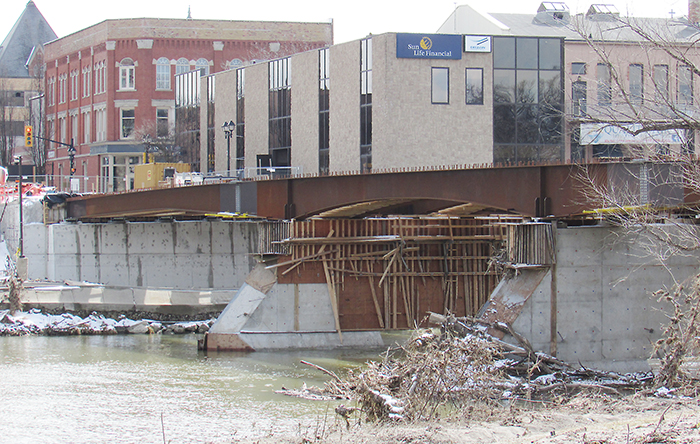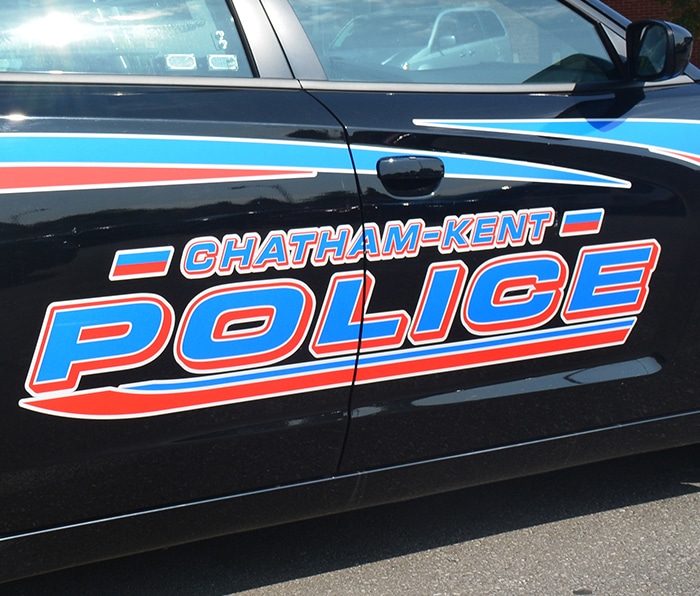
“The proof is in the picture.”
That according to Chatham Coun. Michael Bondy, referring to the front page photo in the March 1 Chatham Voice on how close the floodwaters of the Thames River came to reaching the underside of the Fifth Street Bridge.
While still under construction until June of this year, the rust-covered steel span came within about 18 inches of going from bridge to a dam of sorts.
George Willson, whose Willson Realty office is on Thames Street at the base of the Fifth Street Bridge, said he’s concerned what will happen to the new bridge should we have a repeat of the high water, with a combination of ice and other debris in the future.
“We got off lucky this time; dodged a major bullet. This was just water, no ice,” he said. “If this had been with ice and it had jammed up there because it can’t get underneath the bridge, or there were trees, roots and all the debris that floods bring with them, the water will be pushed back and will flood the whole Thames basin right back to London.”
Willson said the problem lies in the fact there is very little arch to the bridge. The new bridge has little arch compared to the old one because the design includes improved sight lines, an increase in safety for drivers and pedestrians.
But the lack of the arch also means the centre point in the bridge is much closer to the water.
Mark Peacock, general manager of the Lower Thames Valley Conservation Area and a water resources engineer, said he sees nothing wrong with the new bridge design.
“Basically, when they (the municipality) redesigned the bridge, the conservation authority reviewed the plans and confirmed the capacity and the ability to pass things through that bridge had not changed,” he said. “It has the capacity the old bridge had.”
Peacock said the arch is indeed considerably lower to improve sight lines, but added the bridge is designed, like other bridges, to have water pass easily around it if there’s serious flooding.
“You ensure the approaches to the bridge are lower than the bridge itself. It (water) would start flowing around the bridge. That way, you ensure the bridge won’t fail,” he said.
Bondy isn’t convinced.
“Looking at those pictures, if there was ice there, that would be a catastrophic problem,” he said. “In the photo in The Voice, one bridge is arched and the other is not. You can see daylight under the Third Street Bridge but nothing under the Fifth Street Bridge. There’s no arch.”
Willson, who has had offices along the river for more than 35 years, said he was at his office until about 3 p.m. on Feb. 24, and the water came to within about 18 inches of the bottom of the bridge at that time. It peaked about eight hours later, below the bridge, but several inches higher.
Willson and Bondy wonder in the future if a similar flood, with ice and debris added to the mix, would take out the new bridge.
“The other concern is sooner or later, the pressure of the ice on that bridge is going to take it out. When it does take it out it’s going to flood Chatham with the surge,” Willson said.
“If that ever jammed with ice chunks and trees pushed up against the bridge for 72 hours, I’m sure nothing’s built to withstand that,” Bondy said.
Peacock added he thinks there is little chance we’ll see the high water we saw in late February combined with significant ice buildup.
“The flows and the water elevation we saw were extreme. That bridge is designed in line with everything else,” he said. “If we had a couple of metres more of water, that bridge would have been the least of our worries.”
Bondy said he planned on taking Willson’s concerns to municipal staff to hear what they have to say on the matter.






